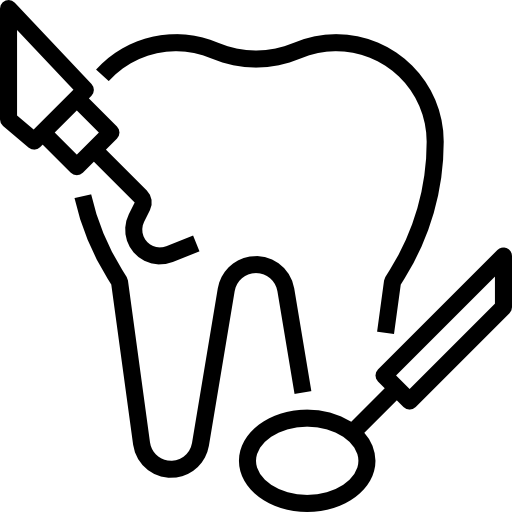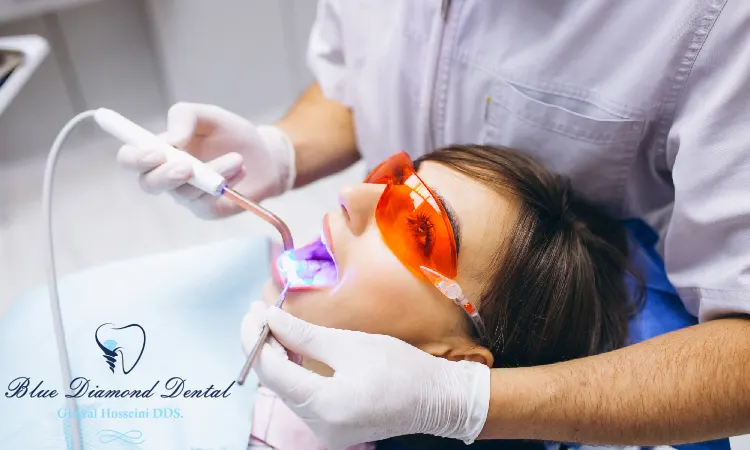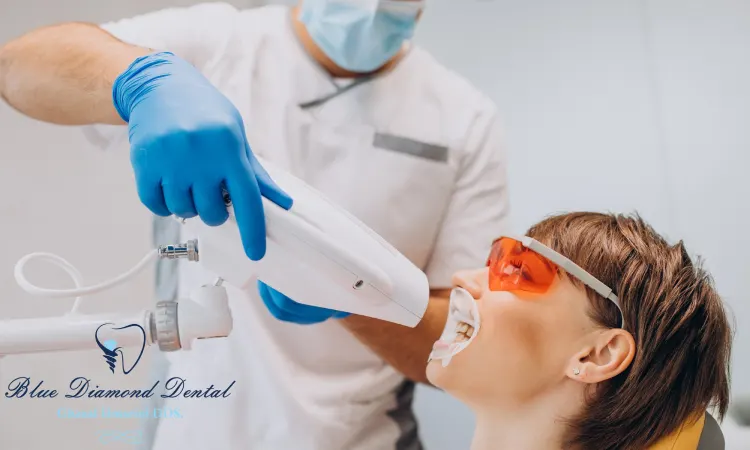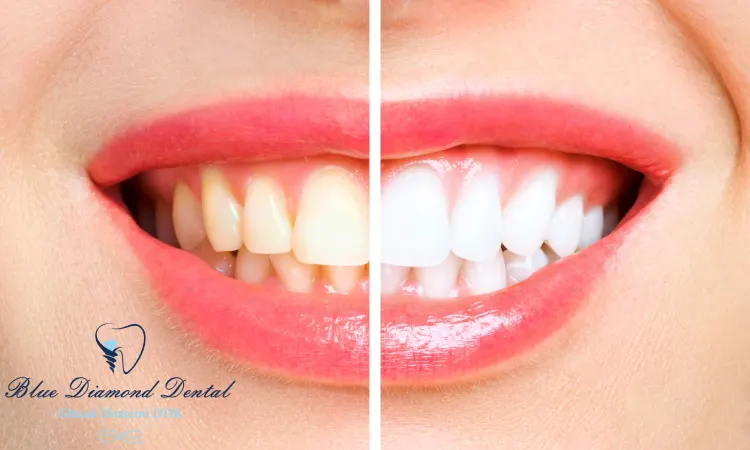- Home
- Services in Blue Diamond Dental

Orthodontics

Pediatric Dentistry
Dental Space Maintainers
Fluoride Treatment
Dental Pulp Treatment
Dental Sealants
Dental Fillings

Cleaning & Prevention

Surgical Dentistry
Tooth extraction
Tooth Extraction Membrane Fell Out
Surgical Placement
Dental bone graft - Contact Us
- About Us
Dental whitening
Dental whitening, also known as teeth bleaching, is a popular cosmetic procedure designed to lighten the color of your teeth. It is a simple and effective way to remove stains and discoloration caused by aging, tobacco use, certain medications, and consuming staining beverages like coffee or red wine. The procedure typically involves using hydrogen peroxide or carbamide peroxide solutions that break down the molecules responsible for tooth discoloration.

While numerous over-the-counter whitening products are available, professional dental whitening offers quicker and more noticeable results. Dentists use more substantial concentrations or specialized techniques to enhance the effectiveness of the treatment. Additionally, they take necessary precautions to protect your gums and sensitive areas during the process. Dental whitening improves your smile’s aesthetics and can boost your self-confidence and overall appearance.
It’s essential to note that dental whitening is not a one-time solution and requires maintenance with proper oral care habits. Regular brushing, flossing, dental check-ups, and avoiding stain-causing foods can significantly extend the longevity of whiter teeth. Ultimately, dental whitening offers a safe and efficient method to achieve a brighter smile that leaves a lasting impression on others while giving you renewed confidence in yourself.
Is dental tooth whitening safe?
One common concern regarding dental tooth whitening is tooth sensitivity. Some individuals may experience increased sensitivity to hot or cold foods and drinks after the procedure. However, this is typically a temporary side effect that can be managed using desensitizing toothpaste or consulting your dentist for further guidance.
Another aspect to consider when evaluating the safety of dental whitening is the potential risk of overusing bleaching agents and damaging the enamel. Overusing or misusing these products can lead to weakened enamel, predisposing teeth to cavities and other dental problems. It’s crucial to consult a qualified dentist who can evaluate your oral health and determine your suitability for dental tooth whitening.

In conclusion, while dental tooth whitening is generally safe when performed correctly by professionals, there are associated risks, such as temporary sensitivity or enamel damage if precautions are not taken into account. To ensure optimum safety during teeth-whitening procedures, seeking guidance from experienced dentists who can tailor treatments based on individual needs is highly recommended. Remember that an attractive smile should not come at the cost of compromising oral health – striking a balance between aesthetics and well-being remains paramount in achieving our desired results safely.
What is the best treatment for teeth whitening?
From over-the-counter whitening strips and gels to professional in-office treatments, choosing the best method for achieving those pearly whites can be overwhelming. However, one treatment stands out amongst the rest: laser teeth whitening.
Laser teeth whitening is becoming increasingly popular due to its superior results and quick procedure time. This treatment involves using a high-intensity laser light on a specially formulated gel applied to the teeth. The light helps activate the gel, allowing it to penetrate deeply and remove stubborn stains on the enamel. Unlike other methods, laser teeth whitening provides immediate results after just one session.

Another effective treatment for teeth whitening is professional take-home kits provided by dentists. These kits consist of custom-made trays and a safe bleaching gel that patients can use at their convenience. While this may take longer than in-office treatments, take-home kits offer greater flexibility and control over the whitening process. Moreover, dentists can monitor progress and guide the duration of treatment to ensure optimal results without any adverse effects.
In conclusion, while there are various methods for teeth whitening available today, laser teeth whitening and professional take-home kits emerge as top contenders in effectiveness and convenience, respectively. Depending on individual preferences, budgetary factors, or recommended suitability by a dentist or orthodontist, these two treatments present viable options for achieving that radiant smile you’re longing for!
What whitening do dentists use?
One standard method is bleaching, which involves using a peroxide-based solution to remove stains and discoloration. The concentration of the solution can vary depending on each patient’s specific needs and goals. In-office bleaching procedures are typically quick and effective, providing noticeable results in just one visit.
Another popular whitening option that dentists use is laser-assisted whitening. This technique combines the application of a specialized gel with the use of a laser device. The heat from the laser helps activate the gel, allowing it to penetrate deep into the teeth and break up stains effectively. Laser-assisted whitening is often preferred by patients who desire immediate results or those with more stubborn discoloration.
Whichever method dentists employ for teeth whitening, it’s important to note that professional supervision ensures safety and optimal outcomes. While over-the-counter whitening products are available, they may provide a different level of effectiveness or customization than those used by dental professionals. Consulting with your dentist before starting any whitening treatment will help determine which option best suits your needs while ensuring comfort and long-lasting results for a brighter smile.
What happens during teeth whitening?
The first step is typically a consultation with a dentist to assess your oral health and determine if you’re a suitable candidate for dental whitening. After this initial assessment, the actual procedure begins.
During the teeth whitening treatment, the dentist usually applies a protective gel or rubber shield to protect your gums from any potential irritation or damage. Then, they use a professional-strength bleaching agent on your teeth. This bleaching agent contains hydrogen peroxide or carbamide peroxide, which helps break down stains on the enamel surface. Some dentists may use specialized light technologies such as LED or lasers to activate and accelerate the whitening process.

As time passes, the bleaching agent works its magic by penetrating deep into the tooth enamel and breaking apart stains at a molecular level. This allows oxygen molecules to enter through enamel pores and bleach away discoloration without causing any harm to your tooth structure. While each person’s experience can vary, most dental whitening treatments take approximately 60-90 minutes, depending on staining severity and desired shade of white.
Teeth whitening is an effective cosmetic procedure that can significantly enhance your smile’s brightness in just one session. It’s important to note that while dental whitening can remove extrinsic stains caused by food and beverages, it may not be as effective at eliminating intrinsic discoloration caused by genetics or medication use. Consulting with an experienced dentist will ensure you receive personalized advice explicitly tailored to your needs for optimal results.
Types of teeth stains
Teeth stains are a common dental concern that can significantly affect self-confidence and oral aesthetics. While there are various causes of teeth discoloration, it is essential to understand the different types of stains in order to address them effectively.
Firstly, extrinsic stains occur on the surface of the teeth and are typically caused by external factors such as frequent consumption of staining beverages like coffee or tea, smoking, or poor oral hygiene. These stains can be addressed through professional dental cleanings and regular brushing with whitening toothpaste.
On the other hand, intrinsic stains originate from within the tooth structure. They are often more challenging to treat as they can result from tooth trauma, certain medications (like tetracycline), or excessive fluoride intake during tooth development. Intrinsic stains are more profound and may require more intensive approaches like dental bleaching procedures or veneers for long-lasting improvement.
Understanding the different types of teeth stains is crucial in determining an appropriate treatment plan for achieving a whiter smile. Consulting with a dental professional specializing in cosmetic dentistry can help identify the cause of your specific stain(s) and provide personalized guidance on effectively achieving optimal results while maintaining oral health.
What are the risks of home kits and salon teeth whitening?
While numerous methods are available for achieving a bright, dazzling smile, home kits and salon teeth whitening come with their fair share of risks. One primary concern is the potential damage to tooth enamel. Teeth whitening products often contain potent chemicals that can erode and weaken enamel over time if used incorrectly or excessively.
Another risk to consider is the unpredictable results of these methods. Home kits typically offer a one-size-fits-all approach, which may only suit some’s needs. Similarly, many salons use generic whitening techniques that may not consider the specific condition of your teeth or any underlying dental issues you might have.
Additionally, it is essential to note the need for more professional supervision during home kit and salon teeth whitening procedures. Without proper guidance from a dentist, there is an increased risk of misusing these products or in excess. This can lead to gum irritation, tooth sensitivity, and other adverse side effects.
In conclusion, while home kits and salon teeth whitening methods may initially seem like convenient and cost-effective options for achieving a whiter smile, it’s crucial to consider the potential risks involved. It is always recommended to consult with a dental professional who can provide personalized advice tailored to your oral health needs before embarking on any teeth whitening journey. Remember: prioritizing safety over speed will ultimately yield better results in the long run.

